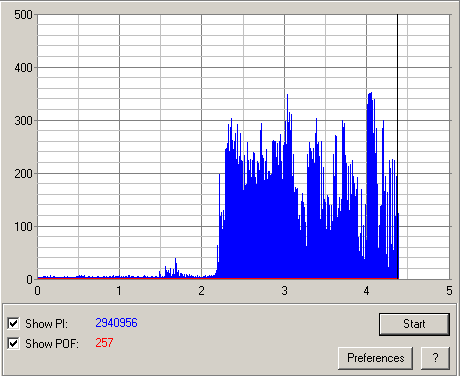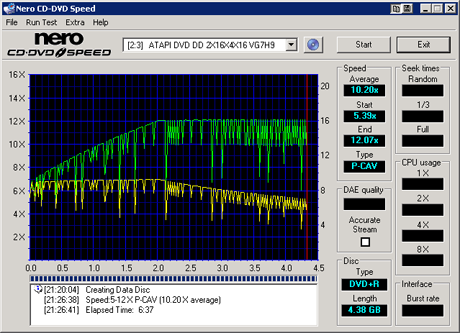Fall 2004 DVDR Roundup: Dual Layer and 16X DVD+R
by Anand Shimpi & Virginia Lee on November 1, 2004 12:05 AM EST- Posted in
- Storage
The Test
We have decided to change the format slightly for this edition of our optical storage roundup. DVD recorders are a lot like graphics cards in some respects; we can simply analyze which burners give us the fastest burn and read speeds, but that is only half of the picture. The other half of any optical storage analysis is the write and read quality. Although many burners have no problems burning a disc at 12X or 16X, reading them back (even in the same drive) doesn't work! Furthermore, if a burner only happens to write and read correctly on one particular type of media, we cannot recommend that as a stable, worthwhile product.Thus, we attempted to answer these questions in a multipart analysis of many different types of media. First, we take the subject drive and write samples of test discs to several different media types. In the US, it is only common to see a few different types of DVDR media, almost all of which we have been tested in our analysis. We go out to retail stores before all of our analyses and buy media for the review. Almost all of our media is store-bought unless stated otherwise. The record speeds of all of these media are noted and displayed near the end of the analysis. We read the disc back in the same drive to make sure it wrote correctly. This read speed is also noted and placed into a chart at the end of our review.
After creating all of these media, we have to determine if they are useful or not. We read the media back in our highly recommended 12X Plextor PX-712A drive. This drive has the additional capability of reading back error data (our MediaTek drives also have this feature). Coupled with the Q-Tools software bundled with Plextor burners, we do two things: read the disc back to make sure it burned correctly, and use Q-Tools to determine how many errors the disc had. Both the read speed and the number of various errors are recorded and charted near the end of the analysis.
Since we record so much data, there are a lot of various graphs that need interpreting. Below is the graph of a poor write of one of our burners, with an explanation of what all the signs mean.
You'll notice that the yellow line on the bottom is the speed of rotation as the disc spins. The green line on the top denotes how fast the disc is being written or read at. Generally, we look for spikes in the graph. Harsh spikes during a read generally indicate that the disc has a poor sector, and the burner is calibrating itself slower to read that particular segment better. Harsh spikes during a read may also indicate a poorly written sector; many burners calibrate speed down when they are starting to loose control of the burn. The exception to this is usually when a write spikes up and stays there - this indicates that the burner can write at a faster speed and is calibrating itself (usually in a step pattern) to do so. Drives that produce a lot of errors won't read back correctly - or at all.
After reading the disc, we run a test that actually counts the number of errors in the Q-Tools software from Plextor. A screenshot of what this software looks like is below.

Here, we see a disc with a moderate number of errors. DVDs use the Reed-Solomon error correction algorithm that allows the drive to detect/correct errors. For DVDs, the graphs indicate parity errors. Although, the PO (parity outer) errors reported by Q-Tools generally refer to uncorrectable errors that will most likely render the disc unreadable if they exist in the double digits. PI errors are generally correctable errors, which are mainly troublesome when there are a large number of them. A disc with a few hundred PI errors is close to a "perfect" while one with a PI error count upwards towards a few hundred thousand general means the entire burn was horrible. These PI errors could result from low quality media with shallow scratches or, more often, a burner with bad media compatibility. Usually firmware updates can fix these issues.











65 Comments
View All Comments
Sabresiberian - Monday, November 1, 2004 - link
#15 DL is important to me because I know the price of media will drop and I want the drive I buy to be as useful as possible for the longest time possible. I might be buying it today but I will be using it tomorrow :) Overall you make some good points :)I think this is a difficult time to do this kind of article, because other improved versions will be available before the end of the year. For example, the Plextor 716A will be released with SATA capabilities.
I think its wierd that you couldn't get the Plextor drive in time, as I know this product has been reviewed by others.
southernpac - Monday, November 1, 2004 - link
A recent (17 August) article in PC World advised extreme caution when buying an OEM (versus retail) DVD burner. It said that OEM units "carry no manufacturer's warranty, lack burning software and are ineligible for firmware upgrades" (therefore costing more in the long run). Many examples were given. I would appreciate advise as to whether this is percieved to be a real concern. If so, NEC has no retail outlet - how would you buy a non-OEM unit?southernpac - Monday, November 1, 2004 - link
A recent (August 17th) PC World article advised extreme caution when buying OEM vs. retail DVD burners. It claimed that OEM versions carry no manufacturer's warranty, lack software and are ineligible for firmware upgrades (therefore actually costing more in the long run). Many examples were given. I would appreciate some advise as to whether this is percieved to be a real risk. If so, NEC has no retail outlet - how would you buy a non-OEM unit? BillGatak - Monday, November 1, 2004 - link
How about overburn tests? I have many times wanted to burn 50-100MB more than a standard single-layer disk but failed because my drive or software won't do it.Codyman - Monday, November 1, 2004 - link
I'm kinda wondering if a PX716A couldn't get crammed into this test somehow. Been waiting for this review in hopes that it would've been in this test and I haven't been waiting the extra couple months for nothing.danidentity - Monday, November 1, 2004 - link
I'd like to see a list of recommended media for different speed grades (4x, 8x, etc.) for different burners.techfuzz - Monday, November 1, 2004 - link
Why weren't the firmware on all the drives tested brought up to at the very least the most recent officially released version? For example, NEC's current official firmware is v2.17 where the v2.16 used in this roundup is the original firmware as-shipped from the factory?!Bozo Galora - Monday, November 1, 2004 - link
firmwares are on www.cdrinfo.comecouser - Monday, November 1, 2004 - link
Doesn’t Samsung make a Dual Layer DVD burner? If so why isn’t it in this roundup?MIDIman - Monday, November 1, 2004 - link
Yay! I'm a winner! I was waiting for this article, but couldn't wait long enough, and picked up the NEC two weeks ago. Couldn't be happier.Here's hoping for better Ritek 8x/16x support...